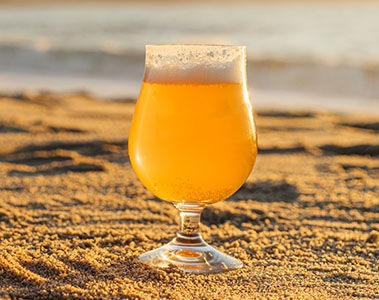
5 May 2022
News
11월 8, 2022
기후 변화로 인한 보리 품질 저하를 해결하기 위해 양조업체들이 어떤 노력을 기울이고 있는지 제품 애플리케이션 전문가 테오 위즈만(Theo Wijsman)이 설명합니다. 자세히 읽어보세요.
Have you been wondering about the future of barley? Research suggest that climate-related weather extremes may threaten the yield and quality of the barley used to brew one of our most-loved beverages: beer. But brewers have not been idle, they have a plan!
For centuries, brewers have soaked barley in water until it sprouts so they could use the malt to create a great tasting beer. However, this age-old process is under threat, due to the overly fluctuating temperatures and variable weather patterns being experienced across the world. One of the more obvious impacts is on barley yield. It’s been known for centuries that yields of barley decline in periods of localized extreme drought and heat. What is striking, is that scientific researchers are now predicting a much more global reduction of barley yield due to climate change: by as much as 17 percent in the coming years, depending on the severity of the conditions. This in turn could lead to supply shortages and price spikes.
It’s not just the yield but the quality of barley that will be negatively affected by climate change. During specific growth stages of barley, if the temperature is too high or there is not enough rain, this in general leads to barley with three changed characteristics: a higher protein content, a lower extract yield, and a lower diastatic power3. Each of these has an impact on beer quality.
Higher protein content may result in beers that are more sensitive to haze formation, which leads to reduced beer stability. Lower extract yield means that the malt contains less starch to be converted to the correct amount of fermentable sugars needed to produce the correct amount of alcohol. As a result, more malt must be used to produce the same amount of beer. A lower diastatic power means that the malt contains reduced amounts of the enzymes such as alfa- and beta-amylase that are responsible for effective conversion of the available starch into fermentable sugars.
In the light of these challenges, how can brewers be prepared to secure the future availability of beer? One direction involves changing various process parameters in the brewing process. For example, it’s possible to extend the mashing duration so that as much extract is converted from the malt as possible. The downside of this is that it can have a negative impact on the production capacity of the brewery.
Another possibility is to solve the filtration problems that arise from poor malt quality and high viscosity. This could be done by a brewery accepting wort that is not as clear as normal, in order to keep capacity levels up. The drawback of this approach is that it will immediately have a negative impact on the quality, taste and flavor of the beer.
In the light of these challenges, how can brewers be prepared to secure the future availability of beer? One direction involves changing various process parameters in the brewing process. For example, it’s possible to extend the mashing duration so that as much extract is converted from the malt as possible. The downside of this is that it can have a negative impact on the production capacity of the brewery.
Another possibility is to solve the filtration problems that arise from poor malt quality and high viscosity. This could be done by a brewery accepting wort that is not as clear as normal, in order to keep capacity levels up. The drawback of this approach is that it will immediately have a negative impact on the quality, taste and flavor of the beer.
At dsm-firmenich, our global brew masters have not been idle either. They have proactively developed a technological solution to help brewers reduce their dependence on barley. Brewers Compass® is an enzyme solution that enables brewing with up to 100% barley and is very suitable for blends of malt with barley and/or adjuncts such as rice, wheat, rye, or oats (which stimulates the cultivation of adjuncts and drives employment in emerging countries). Breweries can now produce a high-quality beer from unmalted barley far easier, more reliably and more cost-effectively than was previously possible.
"Switching from malted to unmalted barley brewing, cuts barley consumption by 10%. Brewing with unmalted barley also uses significantly less water and energy than the traditional barley malting process, which accounts for around 10-15% of the eco-footprint of a beer."
If you want to know more, please contact us and one of our brew masters will be delighted to talk with you about your specific brewing questions or requirements to help your brewery respond proactively to the negative impacts of climate change on barley yield and quality.
Low-quality malt often contains high levels of beta glucan, which can heavily increase the viscosity of wort and/or beer, resulting in filtration problems. These eventually lead to capacity loss or an increase in operational costs.
보리의 미래에 대해 궁금한 점이 있으신가요? 연구에 따르면 기후 관련 이상 기후가 우리가 가장 사랑하는 음료 중 하나인 맥주를 양조하는 데 사용되는 보리의 수확량과 품질을 위협할 수 있다고 합니다. 하지만 양조업자 는 게으름을 피우지 않고 계획이 있습니다!
수세기 동안 양조업자들은 보리가 싹이 날 때까지 물에 담가두었다가 그 맥아를 사용해 훌륭한 맛의 맥주를 만들었습니다. 그러나 전 세계적으로 지나치게 변동하는 기온과 다양한 날씨 패턴으로 인해 이 오래된 과정이 위협받고 있습니다. 가장 분명한 영향 중 하나는 보리 수확량에 대한 것입니다. 국지적인 극심한 가뭄과 더위가 지속되면 보리 수확량이 감소하는 것은 수세기 동안 알려져 왔습니다. 놀라운 점은 과학 연구자들이 기후 변화로 인해 보리 수확량이 향후 몇 년 동안 전 세계적으로 최대 17%까지 감소할 것으로 예측하고 있다는 점입니다(조건의 심각성에 따라 다르지만). 이는 결국 공급 부족과 가격 급등으로 이어질 수 있습니다.
기후 변화로 인해 부정적인 영향을 받는 것은 수확량뿐만 아니라 보리의 품질입니다. 보리의 특정 성장 단계에서 온도가 너무 높거나 비가 충분하지 않으면 일반적으로 단백질 함량이 높고, 추출물 수율이 낮으며, 이완력이 낮은 세 가지 특성이 변경된 보리가 됩니다3. 이들 각각은 맥주 품질에 영향을 미칩니다.
단백질 함량이 높을수록 맥주가 헤이즈 생성에 더 민감해져 맥주 안정성이 떨어질 수 있습니다. 추출 수율이 낮다는 것은 맥아에 정확한 양의 알코올을 생산하는 데 필요한 정확한 양의 발효 가능한 당으로 전환할 수 있는 전분이 덜 포함되어 있다는 것을 의미합니다. 결과적으로 같은 양의 맥주를 생산하려면 더 많은 맥아를 사용해야 합니다. 이완력이 낮다는 것은 맥아에 사용 가능한 전분을 발효 가능한 당으로 효과적으로 전환하는 알파-아밀라아제 및 베타-아밀라아제와 같은 효소의 양이 적다는 것을 의미합니다.
이러한 도전 과제에 비추어 볼 때, 맥주 제조업체는 미래의 맥주 가용성을 확보하기 위해 어떻게 준비할 수 있을까요? 한 가지 방향은 양조 공정에서 다양한 공정 매개변수를 변경하는 것입니다. 예를 들어, 맥아에서 최대한 많은 추출물이 전환되도록 매싱 시간을 연장할 수 있습니다. 단점은 양조장의 생산 능력에 부정적인 영향을 미칠 수 있다는 것입니다.
또 다른 가능성은 낮은 맥아 품질과 높은 점도로 인해 발생하는 여과 문제를 해결하는 것입니다. 이는 양조장에서 용량 수준을 유지하기 위해 평소보다 맑지 않은 맥아즙을 받아들일 때 발생할 수 있습니다. 이 방법의 단점은 맥주의 품질, 맛 및 풍미에 즉시 부정적인 영향을 미친다는 것입니다.
DSM의 글로벌 브루 마스터들도 쉬지 않고 일하고 있습니다. 양조업체들이 보리에 대한 의존도를 낮출 수 있도록 기술 솔루션을 선제적으로 개발했습니다. Brewers Compass® 는 최대 100% 보리로 양조할 수 있는 효소 솔루션으로, 맥아와 보리 및/또는 쌀, 밀, 호밀, 귀리 등의 보조 곡물을 혼합하는 데 매우 적합합니다(보조 곡물 재배를 촉진하고 신흥국의 고용을 촉진합니다). 이제 양조장에서는 맥아를 사용하지 않은 보리로 이전보다 훨씬 쉽고 안정적이며 비용 효율적으로 고품질의 맥주를 생산할 수 있습니다.
자세한 내용은 문의 주세요 양조 마스터 중 한 명이 기꺼이 특정 양조 질문이나 요구 사항에 대해 상담하여 양조장이 기후 변화가 보리 수확량과 품질에 미치는 부정적인 영향에 선제적으로 대응할 수 있도록 도와드릴 것입니다.
저품질 맥아에는 종종 베타글루칸이 많이 함유되어 있어 맥아즙이나 맥주의 점도가 크게 높아져 여과에 문제가 생길 수 있습니다. 이는 결국 용량 손실 또는 운영 비용 증가로 이어집니다.
Brewers Compass® 를 사용하면 맥주 양조자는 맥아 비율 대신 맥아를 사용하지 않은 보리를 사용하여 거품, 맛, 투명도가 뛰어난 고품질 맥주를 만들 수 있으며 비용적인 이점도 얻을 수 있습니다.

5 May 2022

13 August 2022

9 March 2023